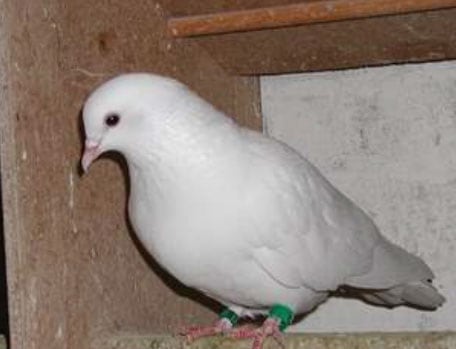A cumulet is a rare and old breed of fancy pigeon popular among fanciers who are interested in speed and racing.
Depending on where you are in the world, you might have heard the cumulet also being called a Haut-volant cumulet, cumulet hochfliger, or altovolante cumulet.
Origins of the Cumulet
The cumulet is believed to have originated in Bulgaria, although there are some experts who believe and sources that state the real location could actually be Germany.
Other early records of the breed also state that they were long used in Belgium as well.
In his book Illustrated Book of Pigeons, the author Robert Fulton records that he had his
first encounter with cumulets in the Belgian city of Malines. Many other English authors around this time also confirm the continental origin of the Cumulet.
Strangely though, they are now considered to be an English breed.
They became popular in England in the early 1800s where they were prized for their sporting prowess. Thye were good in short distance races and records claim the cumulet could stay in the air for 14 hours non-stop.
The most documented period of the development of the cumulet is after they arrived in the UK in the 1870s. Around 1873, a batch of cumulets were sent from Antwerp together with some racing pigeons.
These birds were actually produced in the 1830s when Antwerp smerles were crossed with red neck pigeons – a high flying breed from Vienna that had been introduced to Austria by the Ottoman Army.
The English called the breed cumulet which is the Walloon (French/Belgian dialect) word for tumbling. The Belgians called it the Tuimelaar or Dulker – both being Flemish names for tumbler. In France, it was known as the Skyclimber.
Some schools of thought suggest that the cumulet was named after cumulus clouds being an allusion to the bird’s colour and also to the height to which they can fly.
Whatever the etymology or language, it’s clear the name reflects the flight abilities of the cumulet. It was this ability that made the cumulet popular amongst breeders who wanted to develop sporting pigeons. The cumulet was used in the development of
- Long Flying Tippler in England
- Stralsunder High Flier in Northern Germany
- White Racing Tumbler in Cologne
- Hagenaar in Holland
- Belgian Racing Pigeon
Sadly, the breed lost popularity and is now considered rare. The English Cumulet Club is known to have been dissolved by the 1930s. Cumulet owners in New Zealand – where the breed seems to have some significant popularity – tend to belong to the New Zealand High Flying Club.
Cumulet Pigeon Distribution and Habitat
Cumulets are a domesticated breed, so distribution depends on ownership. There are no cumulets in the wild (unless they have escaped their home).
The breed is happy to exist and thrive in the traditional domestic pigeon conditions, with the special requirement of plenty of room for them to move around and access to direct sunlight.
Appearance of the Cumulet Pigeon
Sadly, as this is now a rare breed, there are no clubs or standards for cumulets that provides in-depth detail.
The cumulet is a beautifully sleek and elegant bird. The body is well-proportioned with powerful wing lock joints. The tail is carried horizontally.

Its most distinguishing feature is the all-white plumage of adult birds. Youngsters usually have red and/or yellow colouring on their wingtips, beard or neck but these will grow out with moulting.
Other standout features are on the pale side: Eyes are pearl/opal with a white pupil, ceres are flesh pink and its feet are also a pale red.
Cumulet Pigeon Character
Being supremely strong fliers, a healthy cumulet can stay aloft in the sky for impressive extended periods, anywhere from between four to ten hours at a time.
They also have excellent homing abilities.
Along with their strength in flight comes a higher than average level of alertness. Cumulets are definitely on the smarter end of the spectrum when it comes to fancy pigeon breeds.
Diet of Cumulet Pigeon
As a domesticated pigeon, cumulets will follow the diet prescribed by their owner. Generally what a pigeon eats is a mix of
- Grains
- Seeds
- Grasses
- Nuts
- Berries
They might also be fed fresh fruit like bananas and vegetables.
Owners may also supplement diets with foods that are believed to improve flight performance and stamina or make up their own food mixes based on ideas published by successful racing bird owners.
They of course need a good supply of fresh water for drinking.
Mating And Breeding Cumulet Pigeons
Being a domestic fancy pigeon breed, the mating and breeding of cumulet pigeons is very much controlled by owners.
Parents are selected based on them having ideal traits and characteristics of the breed, such as perfect colouring, great speed, good weight and height etc.
Taking Care of Cumulet Pigeons
Besides providing more than usual space for the cumulet to move around and keep its flying body in good shape and condition, there isn’t any especially out of the ordinary needed to care for the breed compared to other pigeons of the same size and temperament.
Because of the need for extra space, it is probably a good idea to build your own pigeon loft.
They need a clean, spacious living habitat with access to lots of healthy food and drinking water. They need access to natural sunlight along with a floor that is covered to a good extent.
You will obviously need to commit to regular cleaning of this environment in order to avoid potentially disease-causing contamination.
If you want a beautiful bird with superb flying abilities, you can find cumulets for sale, occasionally.
